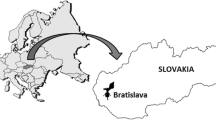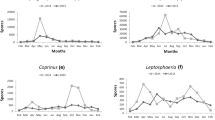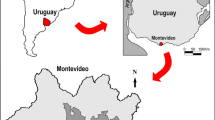Abstract
The aim of this paper was to determine for first time the influence of the main meteorological parameters on the atmospheric fungal spore concentration in Havana (Cuba). This city is characterized by a subtropical climate with two different marked annual rainfall seasons during the year: a “dry season” and a “rainy season”. A nonviable volumetric methodology (Lanzoni VPPS-2000 sampler) was used to sample airborne spores. The total number of spores counted during the 2 years of study was 293,594, belonging to 30 different genera and five spore types. Relative humidity was the meteorological parameter most influencing the atmospheric concentration of the spores, mainly during the rainy season of the year. Winds coming from the SW direction also increased the spore concentration in the air. In terms of spore intradiurnal variation we found three different patterns: morning maximum values for Cladosporium, night peaks for Coprinus and Leptosphaeria, and uniform behavior throughout the whole day for Aspergillus/Penicillium."




Similar content being viewed by others
References
Aira MJ, Rojas TI, Jato V (2002) Fungi associated with three houses in Havana (Cuba). Grana 41:114–118
Aira MJ, Rodríguez-Rajo FJ, Castro M, Jato V (2009) Characterization of Coprinus spores in the NW of the Iberian Peninsula. Identification and count in aerobiological samples. Cryptogam Mycol 30(1):57–66
Aira MJ, Rodríguez-Rajo FJ, Fernández-González M, Seijo C, Elvira-Rendueles B, Gutiérrez-Bustillo M, Abreu I, Pérez-Sánchez E, Oliveira M, Recio M, Morales J, Muñoz AF (2012) Cladosporium airborne spore incidence in the environmental quality of the Iberian Peninsula. Grana 51:293–304
Aira MJ, Rodríguez-Rajo FJ, Fernández-González M, Seijo C, Elvira-Rendueles B, Abreu I, Gutiérrez-Bustillo M, Pérez-Sánchez E, Oliveira M, Recio M, Tormo R, Morales J (2013) Spatial and temporal distribution of Alternaria spores in the Iberian Peninsula atmosphere, and meteorological relationships:1993–2009. J Biometeorol 57(2):265–274
Almaguer M, Rojas TI, Rodríguez-Rajo FJ, Aira MJ (2012) Airborne fungal succession in a rice field of Cuba. Eur J Plant Pathol 133:473–482
Anderson MJ (2001) A new method for non-parametric multivariate analysis of variance. Aust Ecol 26:32–46
Antico A (2000) Environmental factors and allergic airway diseases. Aerobiologia 16:321–326
Arnold GRW, Guerra AG, Rodríguez N (1987) Presencia de hongos en el aire del INIFAT. Reporte de Investigación. Rev INIFAT 43:3–7
Aylor DE (2003) Spread of plant disease on a continental scale: role of aerial dispersal of pathogens. Ecology 84:1989–1997
Barnet HL, Hunter BB (1997) Illustrated genera of imperfect fungi. MacMillan, New York
Borrego S, Perdomo I (2012) Aerobiological investigations inside repositories of the National Archive of the Republic of Cuba. Aerobiologia 28:303–316
Burch M, Levetin E (2002) Effect of meteorological conditions on spore plumes. J Biometeorol 46(3):107–117
Burge HA, Rogers CA (2000) Outdoor allergens. Environ Health Perspect 108(Suppl 4):653–659
Cadrecha J, Fernández de Castro J (1955) Quantitative studies of airborne culturable spores in Havana, Cuba. J Allergy 26(2):150–152
Calderón C, Lacey J, McCartney A, Rosas I (1995) Seasonal and diurnal variation of airborne Basidiomycete spore concentrations in Mexico City. Grana 34:260–268
Calderón C, Lacey J, McCartney A, Rosas I (1997) Influence of urban climate upon distribution of airborne Deuteromycete spore concentrations in Mexico City. Int J Biometeorol 40:71–80
Chew FT, Lim SH, Shang HS, Dahlia MD, Goh DY, Lee BW, Tan HT, Tan TK (2000) Evaluation of the allergenicity of tropical pollen and airborne spores in Singapore. Allergy 55(4):340–347
Corden JM, Millington W, Mullings J (2003) Long term trends and regional variations in the aeroallergen Alternaria in Cardiff and Derby UK—are differences in climate and cereal production having an effect? Aerobiologia 19:191–199
D’Amato G, Cecchi L (2008) Effects of climate change on environmental factors in respiratory allergic disease. Clin Exp Allergy 38:1264–1274
Dames JF, Cadman A (1994) Airspora of Durban: a sub-tropical, coastal South African city. II. Fungal spore component. Grana 33:346–348
Dawidziuk A, Kaczmarek J, Podlesna A, Kasprzyk I, Jedryczka M (2012) Influence of meteorological parameters on Leptosphaeria maculans and L. biglobosa spore release in central and eastern Poland. Grana 51:240–248
de Hoog GS, Guarro J, Gené J, Figueras MJ (2000) Atlas of Clinical Fungi. Centraalbureau voor Schimmelcultures/Universitat Rovira I Virgili, The Nethjerlands
De Linares C, Belmonte B, Canela M, Alba-Sánchez F, Sabariego S, Alonso-Perez S (2010) Dispersal patterns of Alternaria conidia in Spain. Agric For Meteorol 150:1491–1500
Díaz A, Fabré D, Coutin G, González T (2010) La sensibilización a hongos ambientales y su relación con enfermedades atópicas en escolares. Rev Cuban Med Gen Integr 26(4):20–29
Ellis MB (1971) Dematiaceous hyphomycetes. Commonwealth Mycological Institute, Kew
Ellis MB (1976) More dematiaceous hyphomycetes. Commonwealth Mycological Institute, Kew
Galán C, Cariñanos P, Alcázar P, Domínguez E (2007) Manual de Calidad y Gestión de la Red Española de Aerobiología. Servicio de Publicaciones de la Universidad de Córdoba, Córdoba
Gottwald TR, Trocine TM, Timmer LW (1997) A computer-controlled environmental chamber for the study of aerial fungal spore release. Phytopathology 87:1078–1084
Grinn-Gofrón A, Rapiejko P (2009) Occurrence of Cladosporium spp. and Alternaria spp. spores in Western, Northern and Central-Eastern Poland in 2004–2006 and relations to some meteorological factors. Atmos Res 93:747–758. doi:10.1016/2009.02.014
Grinn-Gofroń A, Strzelczak A (2011) The effects of meteorological factors on the occurrence of Ganoderma sp. spores in the air. Int J Biometeorol 55(2):235–241
Halwagy HM (1994) Fungal airspora of Kuwait City, Kuwait, 1975–1987. Grana 33:340–345
Hammer Ø, Harper DAT, Ryan PD (2001) PAST: Paleontological statistics software package for education and data analysis. Palaeontol Electron 4(1):1–9
Hernández B (2002) El Niño-Oscilación del Sur (ENOS) y los frentes fríos que arriban a la región occidental cubana. Investig Mar 30(2):3–19
Herrera L, Carrazana D, Quiñones R (2003) Los hongos anemófilos de la ciudad de Santa Clara, Cuba. Cent Agric 3(30):78–83
Hoa H-M, Raob CY, Hsuc H-H, Chiuc YH, Liud C-M, Chaoc HJ (2005) Characteristics and determinants of ambient fungal spores in Hualien, Taiwan. Atmos Environ 39:5839–5850
Hollins PD, Kettlewell PS, Atkinson MD, Stephenson DB, Corden JM, Millington WM, Mullins J (2004) Relationships between airborne fungal spore concentration of Cladosporium and the summer climate at two sites in Britain. Int J Biometeorol 48:137–141
Hurtado I, Leal FJ, Rodríguez A, García E, Alson-Haran J (1989) A one year survey of airborne pollen and spores in the Neotropical city of Bogotá (Colombia). Allergol Immunopathol 17(2):95–104
Hussain T, Ishtiaq M, Maqbool M, Azam S, Shah A (2013) Incidence of air-borne mycoflora of Bagsar Fort and its allied areas from Samahni valley district Bhimber Azad Kashmir, Pakistan. Afr J Microbiol Res 7(9):724–729
Ianovici N, Tudorica D (2009) Aeromycoflora in outdoor environment of Timisora city (Romania). Not Sci Biol 1:21–28
Jones AM, Harrison RM (2004) The effects of meteorological factors on atmospheric bioaerosol concentrations—a review. Sci Total Environ 326:151–180
Jothish PS, Nayar TS (2004) Airborne fungal spores in a sawmill environment in Palakkad District, Kerala, India. Aerobiologia 20:75–81
Käärik A, Keller J, Kiffer E, Perreau J, Reisinger O (1983) Atlas of airborne fungal spores in Europe. Springer, Berlin
Kasprzyk I, Rzepowska B, Wasylów M (2004) Fungal spores in the atmosphere of Rzeszów (southeast Poland). Ann Agric Environ Med 11:285–289
Kasprzyk I, Grinn-Gofroń A, Strzelczak A, Wolski T (2011) Hourly predictive artificial neural network and multivariate regression trees models of Ganoderma spore concentrations in Rzeszów and Szczecin (Poland). Sci Total Environ 409(5):949–956
Kirk PM, Cannon PF, David JC, Stalpers JA (2001) Dictionary of the fungi. CAB International, Wallingford
Klich MA, Pitt JI (2002) A laboratory guide to the common Aspergillus species and their 19 teleomorphs. CSIRO—Division of Food Processing, Australia
Kurup VP, Shen HD, Vijay H (2002) Immunology and fungal allergens. Int Arch Allergy Immunol 129:181–188
Levetin E, Horner E (2002) Fungal aerobiology: exposure and measurement. Chem Immunol 81:10–27
Lopetegui CM, Malagón GM, Torres Y, Estévez M, González EM (2006) Aplicaciones de la aerobiología en el sistema de predicción y vigilancia de la enfermedad del moho azul del tabaco en la Provincia de Pinar del Rio, Cuba. Avances 8(4):1–11
Mallo AC, Nitiu DS, Gardella Sambeth MC (2011) Airborne fungal spore content in the atmosphere of the city of La Plata, Argentina. Aerobiologia 27:77–84
McArdle BH, Anderson MJ (2001) Fitting multivariate models to community data: a comment on distance based redundancy analysis. Ecology 82:290–297
Mitakakis TZ, Guest DI (2001) A fungal spore calendar for the atmosphere of Melbourne, Australia, for the year 1993. Aerobiologia 17:171–176
Morris CE, Sands DC, Bardin M, Jaenicke R, Vogel B, Leyronas C, Ariya PA, Psenner R (2008) Microbiology and atmospheric processes: an upcoming era of research on bio-meteorology. Biogeosci Discuss 5:191–212
Nilsson S, Persson S (1981) Tree pollen spectra in the Stockholm region (Sweden). 1973–1980. Grana 20:179–182
Oliveira M, Ribeiro H, Abreu I (2005) Annual variation of fungal spores in atmosphere of Porto: 2003. Ann Agric Environ Med 12:309–315
Panda T, Panda B, Mishra N (2009) Seasonal incidence of airborne fungi in coastal belt of Orissa. J Hum Ecol 26(3):205–207
Pitt JI (2000) A laboratory guide to common Penicillium species. Food Science, Australia
Prospero JM, Lamb PJ (2003) African droughts and dust transport to the Caribbean: climate change implications. Science 302:1024–1027
Prospero JM, Blades E, Mathison G, Naidu R (2005) Interhemispheric transport of viable fungi and bacteria from Africa to the Caribbean with soil dust. Aerobiologia 21:1–19
Quintero Fossas JM (1964) Atmospheric fungi. Thesis, University of Puerto Rico
Quintero E, Rivera-Mariani F, Bolaños-Rosero B (2010) Analysis of environmental factors and their effects on fungal spores in the atmosphere of a tropical urban area (San Juan, Puerto Rico). Aerobiologia 26(2):113–124
Rivera-Mariani FE, Bolaños-Rosero B (2012) Allergenicity of airborne basidiospores and ascospores: need for further studies. Aerobiologia 28:83–97
Rivera-Mariani FE, Nazario-Jimenez S, López-Malpica F, Bolaños-Rosero B (2011) Sensitization to airborne ascospores, basidiospores, and fungal fragments in allergic rhinitis and asthmatic subjects in San Juan, Puerto Rico. Int Arch Allergy Immunol 155(4):322–334
Rojas TI, Aira MJ (2012) Fungal biodiversity in indoor environments in Havana, Cuba. Aerobiologia 28:367–374
Rojas TI, Llanes N, Benítez M, Aira MJ, Malagón H (2007) El género Aspergillus en la atmósfera de La Havana (Cuba). Bol Micol 22:41–46
Rosas I, Calderón C, Escamilla B, Ulloa M (1992) Seasonal distribution of Aspergillus in the air of an urban area: Mexico City. Grana 31(4):315–319
Rosas I, McCartney HA, Payne RW, Calderón C, Lacey J, Chapela R, Ruiz-Velasco S (1998) Analysis of the relationships between environmental factors (aeroallergens, air pollution, and weather) and asthma emergency admissions to a hospital in México City. Allergy 53(4):394–401
Sabariego S, Díaz de la Guardia C, Alba F (2000) The effect of meteorological factors on the daily variation of airborne fungal spores in Granada (southern Spain). Int J Biometeorol 44:1–5
Şakiyan N, Inceoglu O (2003) Atmospheric concentration of Cladosporium Link and Alternaria Nées spores in Ankara and the effects of meteorological factors. Turk J Bot 27:77–81
Shaheen IA (1992) Aeromycology of Amman area, Jordan. Grana 31:223–228
Shinn EA, Smith GW, Prospero JM, Betzer P, Hayes ML, Garrison V, Barber RT (2000) African dust and the demise of Caribbean Coral Reefs. Geophys Res 27(19):3029–3032
Stennett PJ, Beggs PJ (2004) Alternaria spores in the atmosphere of Sydney, Australia, and relationships with meteorological factors. Int J Biometeorol 49:98–105
Stepalska D, Wolek J (2009) Intradiurnal periodicity of fungal spore concentrations (Alternaria, Botrytis, Cladosporium, Didymella, Ganoderma) in Cracow, Polonia. Aerobiologia 25:333–340
Tang JW (2009) The effect of environmental parameters on the survival of airborne infectious agents. R Soc Interface 6:737–746
Tashiro N, Noguchi M, Ide Y, Kuchiki F (2013) Sooty spot caused by Cladosporium cladosporioides in postharvest Satsuma mandarin grow in heated greenhouses. J Gen Plant Pathol 79(2):158–161
Venero SJ, Varona P, Fabret D, Suárez R, Bonet M, Molina E (2009) Asma bronquial y rinitis en escolares de Ciudad de La Habana (2001 a 2002). Rev Cubande Hig Epidemiol 47(1):1–5
Acknowledgments
This research was partially supported by the USC-Banco de Santander program.
Author information
Authors and Affiliations
Corresponding author
Rights and permissions
About this article
Cite this article
Almaguer, M., Aira, MJ., Rodríguez-Rajo, F.J. et al. Temporal dynamics of airborne fungi in Havana (Cuba) during dry and rainy seasons: influence of meteorological parameters. Int J Biometeorol 58, 1459–1470 (2014). https://doi.org/10.1007/s00484-013-0748-6
Received:
Revised:
Accepted:
Published:
Issue Date:
DOI: https://doi.org/10.1007/s00484-013-0748-6




